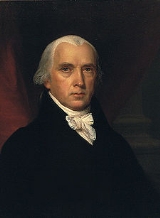
James Madison
Overview
James Madison, Jr. was an American statesman and political theorist. He was the fourth President of the United States
(1809–1817) and is hailed as the “Father of the Constitution” for being the primary author of the United States Constitution
and at first an opponent of, and then a key author of the United States Bill of Rights
. He inherited tobacco land and owned slaves although he spent his entire adult life as a career politician.
His collaboration with Alexander Hamilton
and John Jay
produced the Federalist Papers
(1788), which became the most influential explanation and defense of the Constitution after its publication.
President of the United States
The President of the United States of America is the head of state and head of government of the United States. The president leads the executive branch of the federal government and is the commander-in-chief of the United States Armed Forces....
(1809–1817) and is hailed as the “Father of the Constitution” for being the primary author of the United States Constitution
United States Constitution
The Constitution of the United States is the supreme law of the United States of America. It is the framework for the organization of the United States government and for the relationship of the federal government with the states, citizens, and all people within the United States.The first three...
and at first an opponent of, and then a key author of the United States Bill of Rights
United States Bill of Rights
The Bill of Rights is the collective name for the first ten amendments to the United States Constitution. These limitations serve to protect the natural rights of liberty and property. They guarantee a number of personal freedoms, limit the government's power in judicial and other proceedings, and...
. He inherited tobacco land and owned slaves although he spent his entire adult life as a career politician.
His collaboration with Alexander Hamilton
Alexander Hamilton
Alexander Hamilton was a Founding Father, soldier, economist, political philosopher, one of America's first constitutional lawyers and the first United States Secretary of the Treasury...
and John Jay
John Jay
John Jay was an American politician, statesman, revolutionary, diplomat, a Founding Father of the United States, and the first Chief Justice of the United States ....
produced the Federalist Papers
Federalist Papers
The Federalist Papers are a series of 85 articles or essays promoting the ratification of the United States Constitution. Seventy-seven of the essays were published serially in The Independent Journal and The New York Packet between October 1787 and August 1788...
(1788), which became the most influential explanation and defense of the Constitution after its publication.
Unanswered Questions
Discussions
Quotations
Wherever the real power in a Government lies, there is the danger of oppression. In our Governments, the real power lies in the majority of the Community, and the invasion of private rights is chiefly to be apprehended, not from the acts of Government contrary to the sense of its constituents, but from acts in which the Government is the mere instrument of the major number of the constituents. ![]()
Letter to Thomas Jefferson (1788-10-17)
Perhaps it is a universal truth that the loss of liberty at home is to be charged against provisions against danger, real or pretended from abroad.![]()
Letter to Thomas Jefferson (1798-05-13); published in Letters and Other Writings of James Madison (1865), Vol. II, p. 141

